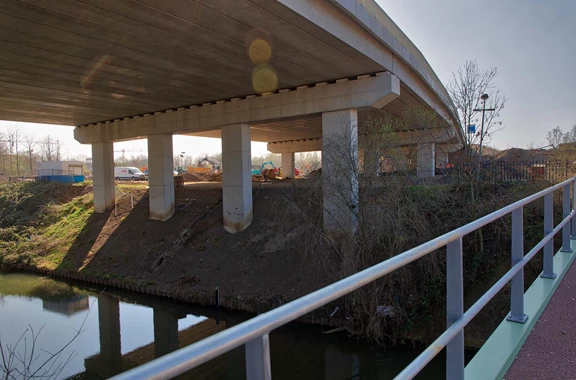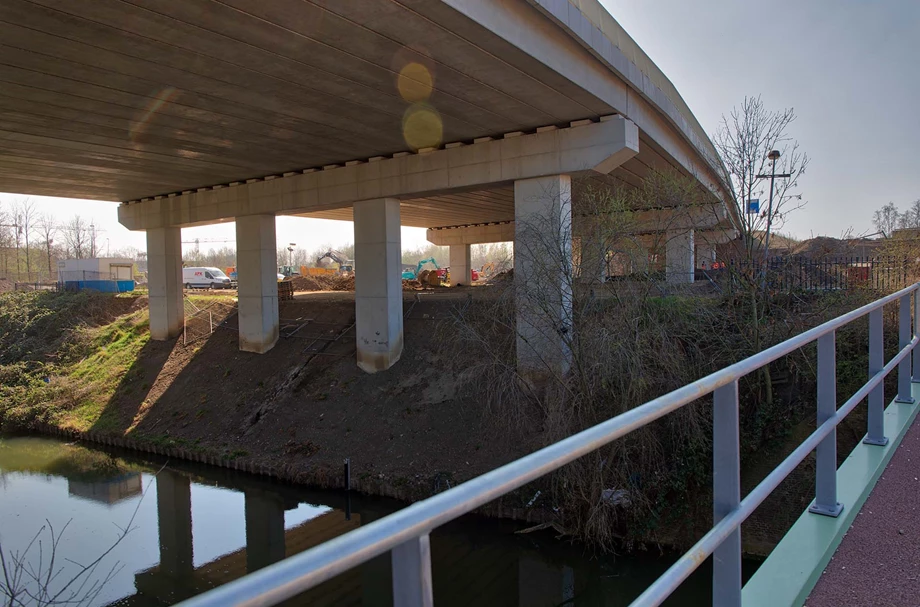


The Noorderbrug project in Maastricht, the Netherlands, aims to improve traffic flow. This concerns the traffic on the north side of the city that has to cross the Meuse.
Bjorn Vink is Senior Advisor at Antea and is closely involved in this infrastructure project. He has previously been involved in similar projects in and around Maastricht. That is why he was asked by the client as an area expert for this project. He also works with Antea colleagues Paul Diederen and Feodor van Heur, and with Arjen Wijdeveld of Deltares. Arjen has a hydrological background and is an expert on leaching.
Vink explains: 'Within the project we mainly focus on the former branch of the Noorderbrug on the west side. A new road has been built here. They used a so-called immobilisate for the foundation. An immobilisate is a mixture of one or more substances with the addition of a binder. Once applied, the immobilisate had to be monitored. We wanted to know how it behaved in the soil. For example, does it leach out? If so, how much? Are the substances contained in it well bound or does it disappear into the environment?'
'In addition to monitoring the immobilisate, we also wanted to monitor groundwater levels and water levels in the canals. For this, we have used monitoring equipment from Royal Eijkelkamp. These gave us more insight into the way in which groundwater levels and water levels relate to each other. For example, the Meuse ebbs and flows and the entire area is affected during high tides. The subsoil of Maastricht and the surrounding area is characterised by many different situations, which makes the groundwater system incredibly complex. We knew about this for certain areas, but it was not known for this specific area. To really get to know the behavior, you just have to measure a lot. This has now been recorded in detail through intensive monitoring.'
'A total of eight groundwater measuring points have been set up and we have used three drains. The drains are used to see if water gets in there. For example, if it rains and water gets in, we know that the immobilisate is permeable in that spot. You'd rather not have that. We also measured the moisture content of the immobilisate. Whether the moisture content increases or dries out is interesting to determine for leaching.'
'The data is sent via modems, after which we can monitor it online in the Web Portal. In that environment we can easily export or import everything. Because we really monitor, we can actually see the project as a full continuous measurement. This gives us a good picture of the hydrological system of the project area. We can see what the influence of channels is, what happens after a heavy rain shower and how the subsurface reacts to immobilisation. We also sometimes receive a warning if it rains and moisture seeps through to a drain. Then a sample must be taken and sent to the lab. Our field employee also checks the monitoring wells if one of the EC or pH meters shows strange values.'
'Before this, I participated in the large-scale tunnel project Avenue2 in Maastricht for this. We had already experienced a lot there, such as problems with pollution and tunnel construction. During pumping, a stain with Volatile Chlorinated Hydrocarbons (VOCL) could simply be sucked into the construction pit. Then we were all working in a moon suit. We wanted to prevent this from happening in the Noorderbrug project, so we did a lot of research for that. Together we have devised a practical monitoring approach to follow any leaching of the immobilized material. Thanks to all the data obtained, we now understand very well how the area works. We can, for example, estimate the speed of a displacement. We also now know exactly when measures need to be taken.'

Need advice choosing the right product for your application? Our specialist Sandra is happy to help.